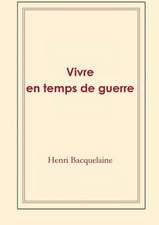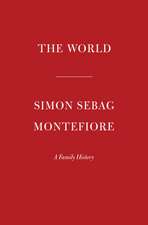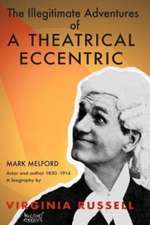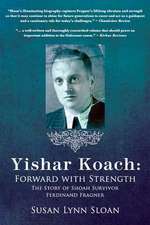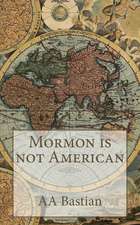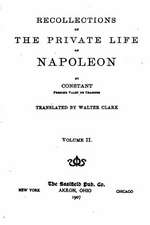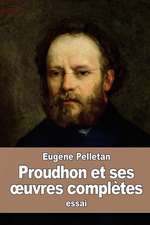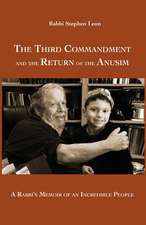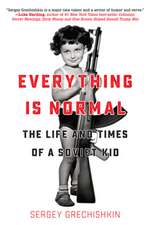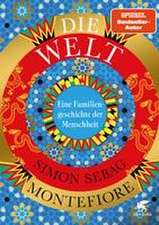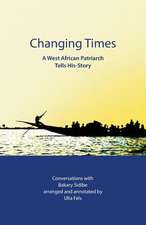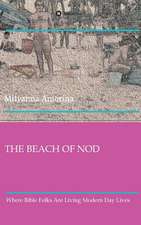Stalin: The Court of the Red Tsar
Autor Simon Sebag Montefioreen Limba Engleză Paperback – 31 aug 2005
Preț: 153.64 lei
Nou
Puncte Express: 230
Preț estimativ în valută:
29.40€ • 31.44$ • 24.51£
29.40€ • 31.44$ • 24.51£
Carte disponibilă
Livrare economică 27 martie-10 aprilie
Preluare comenzi: 021 569.72.76
Specificații
ISBN-13: 9781400076789
ISBN-10: 1400076781
Pagini: 785
Ilustrații: 2 MAPS/32 PP. B&W PHOTOS
Dimensiuni: 133 x 203 x 43 mm
Greutate: 0.77 kg
Editura: Vintage Books USA
ISBN-10: 1400076781
Pagini: 785
Ilustrații: 2 MAPS/32 PP. B&W PHOTOS
Dimensiuni: 133 x 203 x 43 mm
Greutate: 0.77 kg
Editura: Vintage Books USA
Notă biografică
SIMON SEBAG MONTEFIORE is a historian of Russia and the Middle East. Catherine the Great and Potemkin was short-listed for the Samuel Johnson Prize. Stalin: The Court of the Red Tsar won the History Book of the Year Prize at the British Book Awards. Young Stalin won the Los Angeles Times Book Prize for Biography, the Costa Biography Award, and le Grande Prix de la biographie politique. Jerusalem: The Biography was a worldwide best seller. Montefiore's books are published in more than forty languages. He is the author of the novels Sashenka and One Night in Winter, which won the Paddy Power Political Fiction Book of the Year Award in 2014. A Fellow of the Royal Society of Literature, Montefiore graduated from Cambridge University, where he received his PhD. He lives in London.
Extras
Chapter 1:
The Georgian and the Schoolgirl
Nadya and Stalin had been married for fourteen years but it extended deeper and longer than that, so steeped was their marriage in Bolshevism. They had shared the formative experiences of the underground life and intimacy with Lenin during the Revolution, then the Civil War. Stalin had known her family for nearly thirty years and he had first met her in 1904 when she was three. He was then twenty-five and he had been a Marxist for six years.
Joseph Vissarionovich Djugashvili was not born on 21 December 1879, Stalin's official birthday. "Soso" was actually born in a tiny shack (that still exists) to Vissarion, or "Beso," and his wife Ekaterina, "Keke," née Geladze, over a year earlier on 6 December 1878. They lived in Gori, a small town beside the Kura River in the romantic, mountainous and defiantly un-Russian province of Georgia, a small country thousands of miles from the Tsar's capital: it was closer to Baghdad than St. Petersburg.* Westerners often do not realize how foreign Georgia was: an independent kingdom for millennia with its own ancient language, traditions, cuisine, literature, it was only consumed by Russia in gulps between 1801 and 1878. With its sunny climate, clannish blood feuds, songs and vineyards, it resembles Sicily more than Siberia.
Soso's father was a violent, drunken semi-itinerant cobbler who savagely beat both Soso and Keke. She in turn, as the child later recalled, "thrashed him mercilessly." Soso once threw a dagger at his father. Stalin reminisced how Beso and Father Charkviani, the local priest, indulged in drinking bouts together to the fury of his mother: "Father, don't make my husband a drunk, it'll destroy my family." Keke threw out Beso. Stalin was proud of her "strong willpower." When Beso later forcibly took Soso to work as a cobbling apprentice in Tiflis, Keke's priests helped get him back.
Stalin's mother took in washing for local merchants. She was pious and became close to the priests who protected her. But she was also earthy and spicy: she may have made the sort of compromises that are tempting for a penniless single mother, becoming the mistress of her employers. This inspired the legends that often embroider the paternity of famous men. It is possible that Stalin was the child of his godfather, an affluent innkeeper, officer and amateur wrestler named Koba Egnatashvili. Afterwards, Stalin protected Egnatashvili's two sons, who remained friends until his death and reminisced in old age about Egnatashvili's wrestling prowess. Nonetheless, one sometimes has to admit that great men are the children of their own fathers. Stalin was said to resemble Beso uncannily. Yet he himself once asserted that his father was a priest.
Stalin was born with the second and third toes of his left foot joined. He suffered a pock-marked face from an attack of smallpox and later damaged his left arm, possibly in a carriage accident. He grew up into a sallow, stocky, surly youth with speckled honey-coloured eyes and thick black hair-a kinto, Georgian street urchin. He was exceptionally intelligent with an ambitious mother who wanted him to be a priest, perhaps like his real father. Stalin later boasted that he learned to read at five by listening to Father Charkviani teaching the alphabet. The five-year-old then helped Charkviani's thirteen-year-old daughter with her reading.
In 1888, he entered the Gori Church School and then, triumphantly, in 1894, won a "five rouble scholarship" to the Tiflis Seminary in the Georgian capital. As Stalin later told a confidant, "My father found out that along with the scholarship, I also earned money (five roubles a month) as a choirboy . . . and once I went out and saw him standing there: " 'Young man, sir,' said Beso, 'you've forgotten your father . . . Give me at least three roubles, don't be as mean as your mother!'
" 'Don't shout!' replied Soso. 'If you don't leave immediately, I'll call the watchman!' " Beso slunk away.* He apparently died of cirrhosis of the liver in 1909.
Stalin sometimes sent money to help his mother but henceforth kept his distance from Keke whose dry wit and rough discipline resembled his own. There has been too much cod-psychology about Stalin's childhood but this much is certain: raised in a poor priest-ridden household, he was damaged by violence, insecurity and suspicion but inspired by the local traditions of religious dogmatism, blood-feuding and romantic brigandry. "Stalin did not like to speak about his parents and childhood" but it is meaningless to over-analyse his psychology. He was emotionally stunted and lacked empathy yet his antennae were supersensitive. He was abnormal but Stalin himself understood that politicians are rarely normal: History, he wrote later, is full of "abnormal people."
The seminary provided his only formal education. This boarding school's catechismic teaching and "Jesuitical methods" of "surveillance, spying, invasion of the inner life, the violation of people's feelings" repelled, but impressed, Soso so acutely that he spent the rest of his life refining their style and methods. It stimulated this autodidact's passion for reading but he became an atheist in the first year. "I got some friends," he said, "and a bitter debate started between the believers and us!" He soon embraced Marxism.
In 1899, he was expelled from the seminary, joined the Russian Social Democratic Workers' Party and became a professional revolutionary, adopting the nom de revolution Koba, inspired by the hero of a novel, The Parricide, by Alexander Kazbegi, a dashing, vindictive Caucasian outlaw. He combined the "science" of Marxism with his soaring imagination: he wrote romantic poetry, published in Georgian, before working as a weatherman at the Tiflis Meteorological Institute, the only job he held before becoming one of the rulers of Russia in 1917.
"Koba" was convinced by the universal panacea of Marxism, "a philosophical system" that suited the obsessive totality of his character. The class struggle also matched his own melodramatic pugnacity. The paranoid secrecy of the intolerant and idiosyncratic Bolshevik culture dovetailed with Koba's own self-contained confidence and talent for intrigue. Koba plunged into the underworld of revolutionary politics that was a seething, stimulating mixture of conspiratorial intrigue, ideological nitpicking, scholarly education, factional games, love affairs with other revolutionaries, police infiltration and organizational chaos. These revolutionaries hailed from every background-Russians, Armenians, Georgians and Jews, workers, noblemen, intellectuals and daredevils-and organized strikes, printing presses, meetings and heists. United in the obsessional study of Marxist literature, there was always a division between the educated bourgeois émigrés, like Lenin himself, and the rough men of action in Russia itself. The underground life, always itinerant and dangerous, was the formative experience not only of Stalin but of all his comrades. This explains much that happens later.
In 1902, Koba won the spurs of his first arrest and Siberian exile, the first of seven such exiles from which he escaped six times. These exiles were far from Stalin's brutal concentration camps: the Tsars were inept policemen. They were almost reading holidays in distant Siberian villages with one part-time gendarme on duty, during which revolutionaries got to know (and hate) each other, corresponded with their comrades in Petersburg or Vienna, discussed abstruse questions of dialectical materialism, and had affairs with local girls. When the call of freedom or revolution became urgent, they escaped, yomping across the taiga to the nearest train. In exile, Koba's teeth, a lifelong source of pain, began to deteriorate.
Koba avidly supported Vladimir Lenin and his seminal work, What Is to Be Done? This domineering political genius combined the Machiavellian practicality of seizing power with mastery of Marxist ideology. Exploiting the schism that would lead to the creation of his own Bolshevik Party, Lenin's message was that a supreme Party of professional revolutionaries could seize power for the workers and then rule in their name in a "dictatorship of the proletariat" until this was no longer necessary because socialism had been achieved. Lenin's vision of the Party as "the advance detachment" of the "army of proletarians . . . a fighting group of leaders" set the militarist tone of Bolshevism.
In 1904, on Koba's return to Tiflis, he met his future father-in-law Sergei Alliluyev, twelve years his senior, a skilled Russian electrical artisan married to Olga Fedorenko, a strong-willed Georgian-German-Gypsy beauty with a taste for love affairs with revolutionaries, Poles, Hungarians, even Turks. It was whispered that Olga had an affair with the young Stalin, who fathered his future wife, Nadya. This is false since Nadezhda was already three when her parents first met Koba, but his affair with Olga is entirely credible and he himself may have hinted at it. Olga, who, according to her granddaughter Svetlana, had a "weakness for southern men," saying "Russian men are boors," always had a "soft spot" for Stalin. Her marriage was difficult. Family legend has Nadya's elder brother Pavel seeing his mother making up to Koba. Such short liaisons were everyday occurrences among revolutionaries.
Long before they fell in love, Stalin and Nadya were part of the Bolshevik family who passed through the Alliluyev household: Kalinin and Yenukidze among others at that dinner in 1932. There was another special link: soon afterwards, Koba met the Alliluyevs in Baku, and saved Nadya from drowning in the Caspian Sea, a romantic bond if ever there was one.
Koba meanwhile married another sprig of a Bolshevik family. Ekaterina, "Kato," a placid, darkly pretty Georgian daughter of a cultured family, was the sister of Alexander Svanidze, also a Bolshevik graduate of the Tiflis seminary who joined Stalin's Kremlin entourage. Living in a hut near the Baku oilfields, Kato gave him a son, Yakov. But Koba's appearances at home were sporadic and unpredictable.
During the 1905 Revolution, in which Leon Trotsky, a Jewish journalist, bestrode the Petersburg Soviet, Koba claimed he was organizing peasant revolts in the Kartli region of Georgia. After the Tsarist backlash, he travelled to a Bolshevik conference in Tammerfors, Finland-his first meeting with his hero, Lenin, "that mountain eagle." The next year, Koba travelled to the Congress in Stockholm. On his return, he lived the life of a Caucasian brigand, raising Party funds in bank robberies or "expropriations": he boasted in old age of these "heists . . . our friends grabbed 250,000 roubles in Yerevan Square!"
After visiting London for a Congress, Koba's beloved, half-ignored Kato died "in his arms" in Tiflis of tuberculosis on 25 November 1907. Koba was heartbroken. When the little procession reached the cemetery, Koba pressed a friend's hand and said, "This creature softened my heart of stone. She died and with her died my last warm feelings for people." He pressed his heart: "It's desolate here inside." Yet he left their son Yakov to be brought up by Kato's family. After hiding in the Alliluyevs' Petersburg apartment, he was recaptured and returned to his place of banishment, Solvychegodsk. It was in this remote one-horse town in January 1910 that Koba moved into the house of a young widow named Maria Kuzakova by whom he fathered a son.* Soon afterwards, he was involved in a love affair with a schoolgirl of seventeen named Pelageya Onufrieva. When she went back to school, he wrote: "Let me kiss you now. I am not simply sending a kiss but am KISSSSSING you passionately (it's not worth kissing otherwise)." The locals in the north Russified "Iosef" to "Osip" and his letters to Pelageya were often signed by her revealing nickname for him: "Oddball Osip."
After yet another escape, Koba returned to Petersburg in 1912, sharing digs with a ponderous Bolshevik who was to be the comrade most closely associated with him: Vyacheslav Scriabin, only twenty-two, had just followed the Bolshevik custom of assuming a macho nom de revolution and called himself that "industrial name" Molotov-"the hammer." Koba had also assumed an "industrial" alias: he first signed an article "Stalin" in 1913. It was no coincidence that "Stalin" sounds like "Lenin." He may have been using it earlier and not just for its metallic grit. Perhaps he borrowed the name from the "buxom pretty" Bolshevik named Ludmilla Stal with whom he had had an affair.
This "wonderful Georgian," as Lenin called him, was co-opted by the Party's Central Committee at the end of the Prague conference of 1912. In November, Koba Stalin travelled from Vienna to Cracow to meet Lenin with whom he stayed: the leader supervised his keen disciple in the writing of an article expressing Bolshevik policy on the sensitive nationality question, henceforth Stalin's expertise. "Marxism and the National Question," arguing for holding together the Russian Empire, won him ideological kudos and Lenin's trust.
"Did you write all of it?" asked Lenin (according to Stalin).
"Yes . . . Did I make mistakes?"
"No, on the contrary, splendid!" This was his last trip abroad until the Teheran Conference in 1943.
In February 1913, Stalin was rearrested and given a suspiciously light exile: was he an agent of the Tsar's secret police, the Okhrana? The historical sensationalism of Stalin's duplicity shows a naïve misunderstanding of underground life: the revolutionaries were riddled with Okhrana spies but many were double or triple agents.* Koba was willing to betray colleagues who opposed him though, as the Okhrana admitted in their reports, he remained a fanatical Marxist-and that is what mattered.
Stalin's final exile began in 1913 in the distant cold north-east of Siberia, where he was nicknamed "Pock-marked Joe" by the local peasants. Fearing more escapes, the exile was moved to Kureika, a desolate village in Turukhansk, north of the Arctic Circle where his fishing prowess convinced locals of magical powers and he took another mistress. Stalin wrote pitiful letters to Sergei and Olga Alliluyev: "Nature in this cursed region is shamefully poor" and he begged them to send him a postcard: "I'm crazy with longing for nature scenes if only on paper." Yet it was also, strangely, a happy time, perhaps the happiest of his life for he reminisced about his exploits there until his death, particularly about the shooting expedition when he skied into the taiga, bagged many partridges and then almost froze to death on the way back.
The military blunders and food shortages of the Great War inexorably destroyed the monarchy which, to the surprise of the Bolsheviks, collapsed suddenly in February 1917, replaced by a Provisional Government. On 12 March, Stalin reached the capital and visited the Alliluyevs: once again, Nadya, a striking brunette, sixteen, her sister Anna and brother Fyodor, questioned this returning hero about his adventures. When they accompanied him by tram towards the offices of the newspaper Pravda, he called out, "Be sure to set aside a room in the new apartment for me. Don't forget." He found Molotov editing Pravda, a job he immediately commandeered for himself. While Molotov had taken a radical anti-government line, Stalin and Lev Kamenev, né Rosenfeld, one of Lenin's closest comrades, were more conciliatory. Lenin, who arrived on 4 April, overruled Stalin's vacillations.
In a rare apology to Molotov, Stalin conceded, "You were closer to Lenin . . ." When Lenin needed to escape to Finland to avoid arrest, Stalin hid him chez Alliluyev, shaved off his beard and escorted him to safety.
From the Hardcover edition.
The Georgian and the Schoolgirl
Nadya and Stalin had been married for fourteen years but it extended deeper and longer than that, so steeped was their marriage in Bolshevism. They had shared the formative experiences of the underground life and intimacy with Lenin during the Revolution, then the Civil War. Stalin had known her family for nearly thirty years and he had first met her in 1904 when she was three. He was then twenty-five and he had been a Marxist for six years.
Joseph Vissarionovich Djugashvili was not born on 21 December 1879, Stalin's official birthday. "Soso" was actually born in a tiny shack (that still exists) to Vissarion, or "Beso," and his wife Ekaterina, "Keke," née Geladze, over a year earlier on 6 December 1878. They lived in Gori, a small town beside the Kura River in the romantic, mountainous and defiantly un-Russian province of Georgia, a small country thousands of miles from the Tsar's capital: it was closer to Baghdad than St. Petersburg.* Westerners often do not realize how foreign Georgia was: an independent kingdom for millennia with its own ancient language, traditions, cuisine, literature, it was only consumed by Russia in gulps between 1801 and 1878. With its sunny climate, clannish blood feuds, songs and vineyards, it resembles Sicily more than Siberia.
Soso's father was a violent, drunken semi-itinerant cobbler who savagely beat both Soso and Keke. She in turn, as the child later recalled, "thrashed him mercilessly." Soso once threw a dagger at his father. Stalin reminisced how Beso and Father Charkviani, the local priest, indulged in drinking bouts together to the fury of his mother: "Father, don't make my husband a drunk, it'll destroy my family." Keke threw out Beso. Stalin was proud of her "strong willpower." When Beso later forcibly took Soso to work as a cobbling apprentice in Tiflis, Keke's priests helped get him back.
Stalin's mother took in washing for local merchants. She was pious and became close to the priests who protected her. But she was also earthy and spicy: she may have made the sort of compromises that are tempting for a penniless single mother, becoming the mistress of her employers. This inspired the legends that often embroider the paternity of famous men. It is possible that Stalin was the child of his godfather, an affluent innkeeper, officer and amateur wrestler named Koba Egnatashvili. Afterwards, Stalin protected Egnatashvili's two sons, who remained friends until his death and reminisced in old age about Egnatashvili's wrestling prowess. Nonetheless, one sometimes has to admit that great men are the children of their own fathers. Stalin was said to resemble Beso uncannily. Yet he himself once asserted that his father was a priest.
Stalin was born with the second and third toes of his left foot joined. He suffered a pock-marked face from an attack of smallpox and later damaged his left arm, possibly in a carriage accident. He grew up into a sallow, stocky, surly youth with speckled honey-coloured eyes and thick black hair-a kinto, Georgian street urchin. He was exceptionally intelligent with an ambitious mother who wanted him to be a priest, perhaps like his real father. Stalin later boasted that he learned to read at five by listening to Father Charkviani teaching the alphabet. The five-year-old then helped Charkviani's thirteen-year-old daughter with her reading.
In 1888, he entered the Gori Church School and then, triumphantly, in 1894, won a "five rouble scholarship" to the Tiflis Seminary in the Georgian capital. As Stalin later told a confidant, "My father found out that along with the scholarship, I also earned money (five roubles a month) as a choirboy . . . and once I went out and saw him standing there: " 'Young man, sir,' said Beso, 'you've forgotten your father . . . Give me at least three roubles, don't be as mean as your mother!'
" 'Don't shout!' replied Soso. 'If you don't leave immediately, I'll call the watchman!' " Beso slunk away.* He apparently died of cirrhosis of the liver in 1909.
Stalin sometimes sent money to help his mother but henceforth kept his distance from Keke whose dry wit and rough discipline resembled his own. There has been too much cod-psychology about Stalin's childhood but this much is certain: raised in a poor priest-ridden household, he was damaged by violence, insecurity and suspicion but inspired by the local traditions of religious dogmatism, blood-feuding and romantic brigandry. "Stalin did not like to speak about his parents and childhood" but it is meaningless to over-analyse his psychology. He was emotionally stunted and lacked empathy yet his antennae were supersensitive. He was abnormal but Stalin himself understood that politicians are rarely normal: History, he wrote later, is full of "abnormal people."
The seminary provided his only formal education. This boarding school's catechismic teaching and "Jesuitical methods" of "surveillance, spying, invasion of the inner life, the violation of people's feelings" repelled, but impressed, Soso so acutely that he spent the rest of his life refining their style and methods. It stimulated this autodidact's passion for reading but he became an atheist in the first year. "I got some friends," he said, "and a bitter debate started between the believers and us!" He soon embraced Marxism.
In 1899, he was expelled from the seminary, joined the Russian Social Democratic Workers' Party and became a professional revolutionary, adopting the nom de revolution Koba, inspired by the hero of a novel, The Parricide, by Alexander Kazbegi, a dashing, vindictive Caucasian outlaw. He combined the "science" of Marxism with his soaring imagination: he wrote romantic poetry, published in Georgian, before working as a weatherman at the Tiflis Meteorological Institute, the only job he held before becoming one of the rulers of Russia in 1917.
"Koba" was convinced by the universal panacea of Marxism, "a philosophical system" that suited the obsessive totality of his character. The class struggle also matched his own melodramatic pugnacity. The paranoid secrecy of the intolerant and idiosyncratic Bolshevik culture dovetailed with Koba's own self-contained confidence and talent for intrigue. Koba plunged into the underworld of revolutionary politics that was a seething, stimulating mixture of conspiratorial intrigue, ideological nitpicking, scholarly education, factional games, love affairs with other revolutionaries, police infiltration and organizational chaos. These revolutionaries hailed from every background-Russians, Armenians, Georgians and Jews, workers, noblemen, intellectuals and daredevils-and organized strikes, printing presses, meetings and heists. United in the obsessional study of Marxist literature, there was always a division between the educated bourgeois émigrés, like Lenin himself, and the rough men of action in Russia itself. The underground life, always itinerant and dangerous, was the formative experience not only of Stalin but of all his comrades. This explains much that happens later.
In 1902, Koba won the spurs of his first arrest and Siberian exile, the first of seven such exiles from which he escaped six times. These exiles were far from Stalin's brutal concentration camps: the Tsars were inept policemen. They were almost reading holidays in distant Siberian villages with one part-time gendarme on duty, during which revolutionaries got to know (and hate) each other, corresponded with their comrades in Petersburg or Vienna, discussed abstruse questions of dialectical materialism, and had affairs with local girls. When the call of freedom or revolution became urgent, they escaped, yomping across the taiga to the nearest train. In exile, Koba's teeth, a lifelong source of pain, began to deteriorate.
Koba avidly supported Vladimir Lenin and his seminal work, What Is to Be Done? This domineering political genius combined the Machiavellian practicality of seizing power with mastery of Marxist ideology. Exploiting the schism that would lead to the creation of his own Bolshevik Party, Lenin's message was that a supreme Party of professional revolutionaries could seize power for the workers and then rule in their name in a "dictatorship of the proletariat" until this was no longer necessary because socialism had been achieved. Lenin's vision of the Party as "the advance detachment" of the "army of proletarians . . . a fighting group of leaders" set the militarist tone of Bolshevism.
In 1904, on Koba's return to Tiflis, he met his future father-in-law Sergei Alliluyev, twelve years his senior, a skilled Russian electrical artisan married to Olga Fedorenko, a strong-willed Georgian-German-Gypsy beauty with a taste for love affairs with revolutionaries, Poles, Hungarians, even Turks. It was whispered that Olga had an affair with the young Stalin, who fathered his future wife, Nadya. This is false since Nadezhda was already three when her parents first met Koba, but his affair with Olga is entirely credible and he himself may have hinted at it. Olga, who, according to her granddaughter Svetlana, had a "weakness for southern men," saying "Russian men are boors," always had a "soft spot" for Stalin. Her marriage was difficult. Family legend has Nadya's elder brother Pavel seeing his mother making up to Koba. Such short liaisons were everyday occurrences among revolutionaries.
Long before they fell in love, Stalin and Nadya were part of the Bolshevik family who passed through the Alliluyev household: Kalinin and Yenukidze among others at that dinner in 1932. There was another special link: soon afterwards, Koba met the Alliluyevs in Baku, and saved Nadya from drowning in the Caspian Sea, a romantic bond if ever there was one.
Koba meanwhile married another sprig of a Bolshevik family. Ekaterina, "Kato," a placid, darkly pretty Georgian daughter of a cultured family, was the sister of Alexander Svanidze, also a Bolshevik graduate of the Tiflis seminary who joined Stalin's Kremlin entourage. Living in a hut near the Baku oilfields, Kato gave him a son, Yakov. But Koba's appearances at home were sporadic and unpredictable.
During the 1905 Revolution, in which Leon Trotsky, a Jewish journalist, bestrode the Petersburg Soviet, Koba claimed he was organizing peasant revolts in the Kartli region of Georgia. After the Tsarist backlash, he travelled to a Bolshevik conference in Tammerfors, Finland-his first meeting with his hero, Lenin, "that mountain eagle." The next year, Koba travelled to the Congress in Stockholm. On his return, he lived the life of a Caucasian brigand, raising Party funds in bank robberies or "expropriations": he boasted in old age of these "heists . . . our friends grabbed 250,000 roubles in Yerevan Square!"
After visiting London for a Congress, Koba's beloved, half-ignored Kato died "in his arms" in Tiflis of tuberculosis on 25 November 1907. Koba was heartbroken. When the little procession reached the cemetery, Koba pressed a friend's hand and said, "This creature softened my heart of stone. She died and with her died my last warm feelings for people." He pressed his heart: "It's desolate here inside." Yet he left their son Yakov to be brought up by Kato's family. After hiding in the Alliluyevs' Petersburg apartment, he was recaptured and returned to his place of banishment, Solvychegodsk. It was in this remote one-horse town in January 1910 that Koba moved into the house of a young widow named Maria Kuzakova by whom he fathered a son.* Soon afterwards, he was involved in a love affair with a schoolgirl of seventeen named Pelageya Onufrieva. When she went back to school, he wrote: "Let me kiss you now. I am not simply sending a kiss but am KISSSSSING you passionately (it's not worth kissing otherwise)." The locals in the north Russified "Iosef" to "Osip" and his letters to Pelageya were often signed by her revealing nickname for him: "Oddball Osip."
After yet another escape, Koba returned to Petersburg in 1912, sharing digs with a ponderous Bolshevik who was to be the comrade most closely associated with him: Vyacheslav Scriabin, only twenty-two, had just followed the Bolshevik custom of assuming a macho nom de revolution and called himself that "industrial name" Molotov-"the hammer." Koba had also assumed an "industrial" alias: he first signed an article "Stalin" in 1913. It was no coincidence that "Stalin" sounds like "Lenin." He may have been using it earlier and not just for its metallic grit. Perhaps he borrowed the name from the "buxom pretty" Bolshevik named Ludmilla Stal with whom he had had an affair.
This "wonderful Georgian," as Lenin called him, was co-opted by the Party's Central Committee at the end of the Prague conference of 1912. In November, Koba Stalin travelled from Vienna to Cracow to meet Lenin with whom he stayed: the leader supervised his keen disciple in the writing of an article expressing Bolshevik policy on the sensitive nationality question, henceforth Stalin's expertise. "Marxism and the National Question," arguing for holding together the Russian Empire, won him ideological kudos and Lenin's trust.
"Did you write all of it?" asked Lenin (according to Stalin).
"Yes . . . Did I make mistakes?"
"No, on the contrary, splendid!" This was his last trip abroad until the Teheran Conference in 1943.
In February 1913, Stalin was rearrested and given a suspiciously light exile: was he an agent of the Tsar's secret police, the Okhrana? The historical sensationalism of Stalin's duplicity shows a naïve misunderstanding of underground life: the revolutionaries were riddled with Okhrana spies but many were double or triple agents.* Koba was willing to betray colleagues who opposed him though, as the Okhrana admitted in their reports, he remained a fanatical Marxist-and that is what mattered.
Stalin's final exile began in 1913 in the distant cold north-east of Siberia, where he was nicknamed "Pock-marked Joe" by the local peasants. Fearing more escapes, the exile was moved to Kureika, a desolate village in Turukhansk, north of the Arctic Circle where his fishing prowess convinced locals of magical powers and he took another mistress. Stalin wrote pitiful letters to Sergei and Olga Alliluyev: "Nature in this cursed region is shamefully poor" and he begged them to send him a postcard: "I'm crazy with longing for nature scenes if only on paper." Yet it was also, strangely, a happy time, perhaps the happiest of his life for he reminisced about his exploits there until his death, particularly about the shooting expedition when he skied into the taiga, bagged many partridges and then almost froze to death on the way back.
The military blunders and food shortages of the Great War inexorably destroyed the monarchy which, to the surprise of the Bolsheviks, collapsed suddenly in February 1917, replaced by a Provisional Government. On 12 March, Stalin reached the capital and visited the Alliluyevs: once again, Nadya, a striking brunette, sixteen, her sister Anna and brother Fyodor, questioned this returning hero about his adventures. When they accompanied him by tram towards the offices of the newspaper Pravda, he called out, "Be sure to set aside a room in the new apartment for me. Don't forget." He found Molotov editing Pravda, a job he immediately commandeered for himself. While Molotov had taken a radical anti-government line, Stalin and Lev Kamenev, né Rosenfeld, one of Lenin's closest comrades, were more conciliatory. Lenin, who arrived on 4 April, overruled Stalin's vacillations.
In a rare apology to Molotov, Stalin conceded, "You were closer to Lenin . . ." When Lenin needed to escape to Finland to avoid arrest, Stalin hid him chez Alliluyev, shaved off his beard and escorted him to safety.
From the Hardcover edition.
Recenzii
“Terrific. . . . Scholarship as a kind of savage gossip. . . . Deeply researched, wonderfully readable.” –Time “The first intimate portrait of a man who had more lives on his conscience than Hitler. . . . Disturbing and perplexing.” –Richard Pipes, The New York Times Book Review“Superb. . . . No Western writer has got as close. . . . A dark and excellent book.” –The New York Review of Books“A harrowing portrait of life in the dictator’s inner circle. . . . [Stalin] emerges from this book as a contradictory, creepily flesh-and-blood human being.” –The New York Times“Unprecedented in its intimacy and horrifying in its implications, not merely because it shows that the engineers of one of history’s greatest holocausts were depraved . . . but also because they emerge in these pages as surprisingly normal.” –The Washington Post Book World
Descriere
In this unprecedented biography of the Soviet tyrant and of the men and women who sustained him in power for nearly 30 years, Montofiore offers a seamless meshing of new and exhaustive research, brilliant synthesis, and narrative lan. 24 pages of photos. 2 maps.


